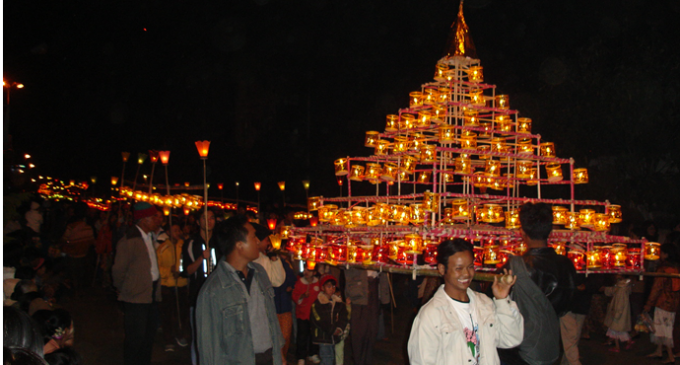Tazaungdine Festival

Unsatisfied yet with the fun of the lighting festival of Thadingyut, the people start looking for an excuse to have another lighting festival. Thadingyut’s lightings are closely connected with Buddhist legend but Tazaungmon lightings or Tazaungdaing are merely a recurrence of the Thadingyut festival under a pretext. Tazaung- daing means a pillar of lights (‘tansaung’, pronounces ‘tazaung’ — lights; ‘taing’, pronoun-ces daing here–post or pillar).
Tazaungmon (November) is the month when the Krattika planet (Pleiades) accompanies the Moon, and when Mahavinayaka awakes from his long slumber. It is a pre-Buddhist custom in Myanmar to do homage to this deity on the Full Moon night of Tazaungmon with offerings of incense, sweetmeats and lights.
 Tazaungdaing is therefore non-Buddhistic in origin but Myanmar genius for adaptation does not find it hard to connect it with Buddhism. The Buddha’s mother, reincarnated as a god in Tavatimsa, perceived from her heavenly abode that her son would soon be discarding the royal robes and wearing a monk’s garments. She wanted to provide the yellow robes of the monk and she had only a night’s time. But she had it woven in a single night and offered to the prince (Siddhatha) by a celestial messenger. In memory of this expedition, the Myanmar people would, on the evening of the Full Moon Day of Tazaungmon, organize into teams to make a piece of yellow robe for the Lord.
Tazaungdaing is therefore non-Buddhistic in origin but Myanmar genius for adaptation does not find it hard to connect it with Buddhism. The Buddha’s mother, reincarnated as a god in Tavatimsa, perceived from her heavenly abode that her son would soon be discarding the royal robes and wearing a monk’s garments. She wanted to provide the yellow robes of the monk and she had only a night’s time. But she had it woven in a single night and offered to the prince (Siddhatha) by a celestial messenger. In memory of this expedition, the Myanmar people would, on the evening of the Full Moon Day of Tazaungmon, organize into teams to make a piece of yellow robe for the Lord.
 As soon as the sun sets, cotton seeds are strewn on the ground, symbolic of the sowing; the full moon enchants you to believe that plants grow up, and so the cotton is plucked; it is then cleaned of dirt, dressed, i.e., beaten with a bowstring, ginned and spun into thread, the thread then undergoes a series of complica- ted operations and is put to the weaving loom. The weavers feverishly weave on to obtain enough cloth for a piece of yellow robe. They cut up the cloth into bits, and have it stitched up into a garment, ready for the offering by dawn. If it is belated, it is taken as a failure. The yellow robe is therefore called “Matho- thingan” (Matho, not stale i.e., fresh; here; “done before dawn; Thingan, the monk’s yellow robe”). Much laughter and merriment accompanies this festival. For instance when the girls are plucking the cotton, a mischievous but sportive group of young men would cover themselves with blan-kets and pretending themselves as elephants, chase the girls, who would take their cue and feign fright.
As soon as the sun sets, cotton seeds are strewn on the ground, symbolic of the sowing; the full moon enchants you to believe that plants grow up, and so the cotton is plucked; it is then cleaned of dirt, dressed, i.e., beaten with a bowstring, ginned and spun into thread, the thread then undergoes a series of complica- ted operations and is put to the weaving loom. The weavers feverishly weave on to obtain enough cloth for a piece of yellow robe. They cut up the cloth into bits, and have it stitched up into a garment, ready for the offering by dawn. If it is belated, it is taken as a failure. The yellow robe is therefore called “Matho- thingan” (Matho, not stale i.e., fresh; here; “done before dawn; Thingan, the monk’s yellow robe”). Much laughter and merriment accompanies this festival. For instance when the girls are plucking the cotton, a mischievous but sportive group of young men would cover themselves with blan-kets and pretending themselves as elephants, chase the girls, who would take their cue and feign fright.

Mezali
A popular delicacy on such nights is the Mezali (Cassia siamea) flower-buds of the tree with medicinal qualities, boiled and seasoned with sesames, groundnut, fried garlic, etc.
Some hold the belief that the Mezali has supreme medicinal values on the Full Moon night of Tazaungmon when the moon attains meridian because at that particular time of the year the guardian god of the tree is glorified and paid homage to by all the other gods. This, again, is a pre-Buddhistic belief.
The Full Moon night of Tazaung-mon is also popularly believed to be an auspicious time when all the stars of the firmament acquire a special luminosity, and their assemblage is fullest. If that is so, the assemblage is made even more complete by the fire balloons, the heaven-ward pilgrims to the Culamuni.
This is also a sanctified season, this month of Tazaungmon. For the yellow robes offered to the monkhood during the period, beginning from the First Waning Day of Thadingyut and ending on the Full Moon Day of Tazaungmon, carry with them special virtues that can nullify certain minor faults in the wearer, thereby rendering the gift more meritorious. The yellow robes offered in this season are called “Kathein thingan” because the donors, in making their offering, say “This Kathina Civaram we do give to the Sangha”. From Kathina Civaram, we get “Kathein thingan.” The offering itself is made in accordance with certain prescribed rules but they need not be explained here. Suffice it to say that Kathein Thingan is a special and seasonal gift of yellow robes received by the monkhood according to the Vinaya Law.
An offering of Kathein thingan is usually a big affair. In Mandalay, Shwebo and Sagaing for instance, they may be a pooling of gifts of the whole town or major sections of the townspeople such as the ministerial staff, the commercial community, the transport services, etc. Although “Thingan” is the prime gift, there are a thousand and one gifts accompanying it in these offering ceremonies. Theatrical enter-tainments of sorts is a common feature, the season itself being very favourable to night-long amusements. On these nights there would not only be stalls where one can buy eatables but also free refreshment booths (Neibban-zay).
On the day of offering, the gifts, tied to moveable stands symbolising the fabulous Padesa tree or Kalpa Vriksa of the primeval days from which you could wish for and get anything you wanted, are lined up in procession, accompanied by much music and dancing, brought to the chosen monastery and offered to the monks in ceremony. Because the gifts are displayed before being offered, the festival is commonly called “Kathein-Khin” — “Khin” meaning “to display”.
The Kathein festivals account for the greatest significance in Tazaungmon. Poets of the past have referred to them in common. To cite one here, we have Maha Atula Mingyi’s Lwan-gyin (a romantic song).
“. . . Of the twelve months, Tazaungmon, making one’s bosom cold, is the month when the Moon enters the orbit of the Vrsceika (Scorpio); when the Luffa plant is in full bloom, spreading its aroma all round; and when the great noble kings make Kathein offering.”
Ye Dwe
./wp-content/uploads/2018/10/Emirate-Online-TDY.png)
















There are no comments at the moment, do you want to add one?
Write a comment